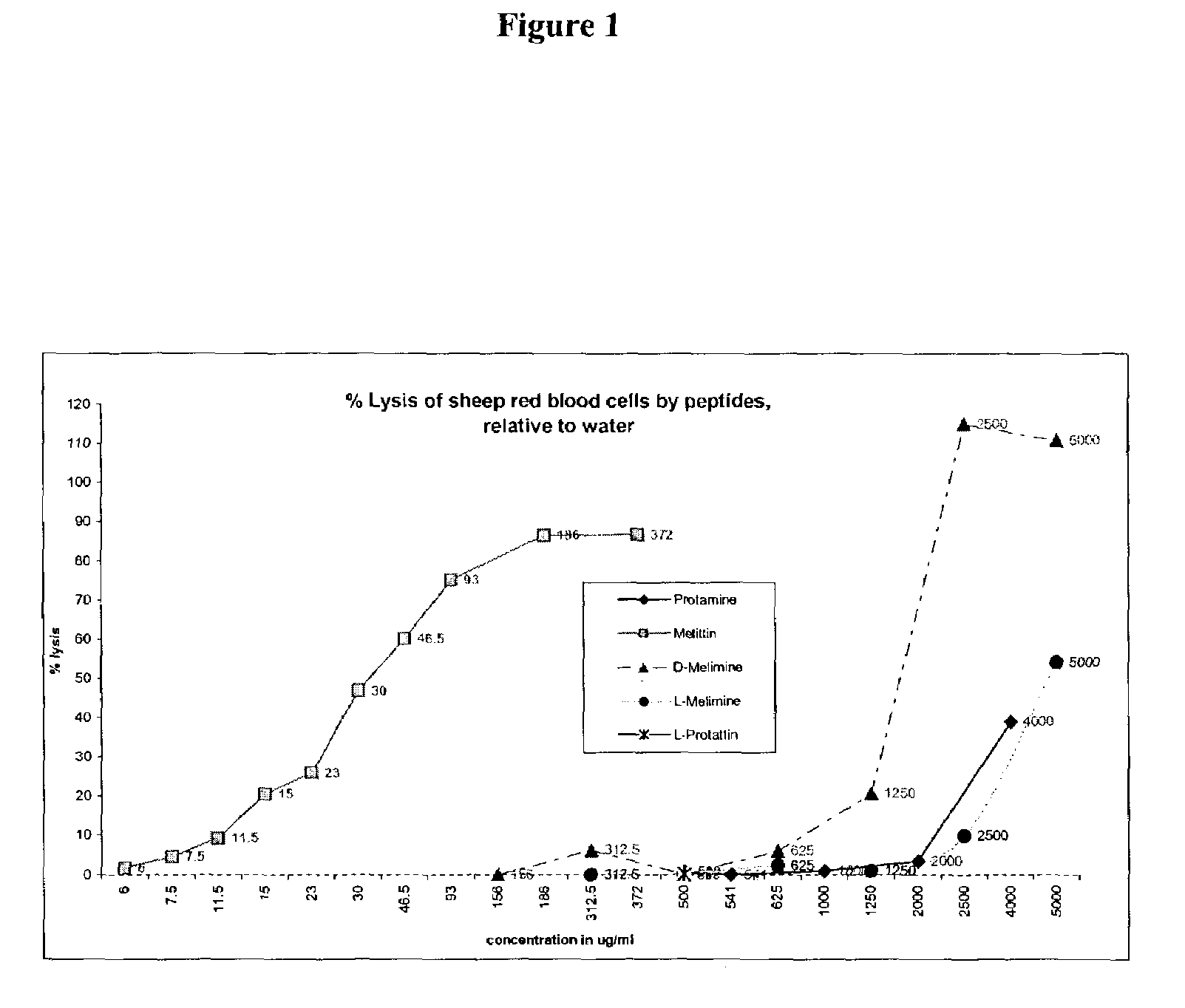Biomedical devices with antimicrobial coatings
a biomedical device and antimicrobial technology, applied in the field of coating devices, can solve the problems of prior art coatings, ocular toxicity or allergic reactions, and the use of known antimicrobial coatings has disadvantages,
- Summary
- Abstract
- Description
- Claims
- Application Information
AI Technical Summary
Benefits of technology
Problems solved by technology
Method used
Image
Examples
example 1
[0047]To assess the effect of cationic proteins / peptides in solution against bacterial cells, Psudomonas aeruginosa 6294 and Staphylacoccus aureus 31 cells were grown as for 18 hours in Tryptone Soya Broth (TSB) at 35° C. The cells were then harvested by centrifugation and washed twice in phosphate buffered saline (PBS; NaCl 8 g / l; KCl 0.2 g / l; Na2HPO41.15 g / l; KH2PO40.2 g / l). The cells were then re-suspended to OD 0. 1 at 660 nm in PBS. The cationic peptide was serially diluted from 1 mg / ml and dilutions were added to wells in a 96 well microtitre plate or into 5 ml disposable test-tubes. Controls were bacteria without peptides. Bacteria were incubated for 18 hours at 35° C. and turbidity was measured at 660 nm. A lack of turbidity in the test-tube corresponding to the peptide dilution was considered to be the minimum inhibitory concentration (“MIC”).
[0048]
TABLE 1S.a.S.a.CKP.aP.aPeptideSequence315629415442MelimineTLISWIKNKRKQRP125250RRRVSRRRRRRGGRRRRSEQ ID NO. 3ProttatinRPRVSRRRRRR...
example 2
[0050]For conducting viable counts, Etafilcon A lenses were removed from the manufacturers vials, washed three times in 1 ml PBS, dried and then coated by pipetting 500 μg L-Melimine onto the contact lenses (melimine was dissolved in distilled water and air dried onto contact lenses) overnight at ambient temperature in a fume hood. The number of lenses used for each strain is shown in Table 2 in parenthesis. Lenses were rehydrated in PBS for 10 minutes and 0.5 ml of 1×108 bacterial cells / ml, including gram-positive S. aureus and gram-negative P. aeruginosa were added to the lenses. After incubation at ambient temperature for either 10 min or 5 hours, the lenses were washed three times in PBS to remove non-adherent or loosely adherent bacteria. Lenses were then homogenized using tissue homogenizer and 1 ml PBS until lens disintegration (about 1–2 minutes). Serial dilutions were then made according to the technique of Miles and Misra and aliquots (20 μL) plated out on nutrient agar. A...
example 3
[0053]Etafilcon lenses, commercially available from Johnson & Johnson as ACUVUE® Brand contact lenses) were soaked as in Example 2, above, except that the L-melimine concentration was varied: 125 μg, 250 μg or 500 μg / lens. After absorption of L-Melimine onto the hydrogel polymer, the lenses were rehydrated with PBS, and exposed to S. aureus or P. aeruginosa for either 10 minutes or five hours, as described in Example 2. After exposure, the polymer was evaluated for numbers of microorganisms the standard Miles and Misra plate count assay.
[0054]
TABLE 3Bacterial% reduction at 10 min% reduction at 5 hrsStrain125 μg250 μg500 μg125 μg250 μg500 μgP. aeruginosa−19 ± 41 (4)27 ± 15 (4)44 ± 30 (4)60 ± 40 (8)77 ± 11 (4)93 ± 2 (3)6294S. aureus 31−1361 ± 1745 (4)−127 ± 254 (3) 62 ± 32 (5)−81 ± 98 (5) −163 ± 266 (3) 77 ± 21 (3)Number of lenses tested shown in ( )
[0055]The results in Table 3 show that, with a decreased concentration of L-Melimine, there was a corresponding decrease in the numbe...
PUM
| Property | Measurement | Unit |
|---|---|---|
| temperature | aaaaa | aaaaa |
| pH | aaaaa | aaaaa |
| contact time | aaaaa | aaaaa |
Abstract
Description
Claims
Application Information
 Login to View More
Login to View More - R&D
- Intellectual Property
- Life Sciences
- Materials
- Tech Scout
- Unparalleled Data Quality
- Higher Quality Content
- 60% Fewer Hallucinations
Browse by: Latest US Patents, China's latest patents, Technical Efficacy Thesaurus, Application Domain, Technology Topic, Popular Technical Reports.
© 2025 PatSnap. All rights reserved.Legal|Privacy policy|Modern Slavery Act Transparency Statement|Sitemap|About US| Contact US: help@patsnap.com

